Smoking's Impact on the Lungs
Ex-smokers are often tempted when watching others smoke. Spending time with a specific friend and watching them smoke may be a trigger, especially if it was the most time you had spent with the friend since you quit smoking. The first time you have any new experiences, even if smoking is not part of the ritual, the thought for a cigarette will seem like a natural part of the ritual.
Another factor is when watching a person smoke, the natural tendency is for the ex-smoker to start to fantasize about how good a cigarette will be at that given moment. A more productive way to handle the situation though is to really watch the person smoke one, and then wait a few minutes as they light another and then another.
Soon you will see that they are smoking in a way that you don't want to and probably in a way that they don't want to either. But they have no choice. You do. I am attaching a letter here that addresses this issue. It is a little harder to describe because it is based on a demonstration I do at live seminars.
One demonstration I do at all my live seminars is a little smoking contraption made out of a plastic Palmolive bottle with a mouth piece inserted to hold a cigarette. The simulation shows how much smoke comes in when a person inhales, and how much comes out when they exhale.
Smokers often feel they take in smoke and then blow most of it out, when in actuality, a very small percent actually comes out (about 10%). I always use cigarettes given to me by people in the audience. If I used one I had brought, people would think I was using a loaded cigarette.
Anyway, below is a letter I wrote for clinic graduates who have seen this demonstration, but the concepts apply to those who haven't also. Viewing smoking as it really looks will minimize the temptation for even a puff.
The letter is as follows ...
Whenever you watch a person smoking, think of the Palmolive bottle demonstration you saw the first day of the Stop Smoking Clinic. Visualize all of the smoke that goes into the bottle that doesn't come out.
Also, remember that the smoker is not only going to smoke that one cigarette. He will probably smoke another within a half-hour. Then another after that. In fact, he will probably smoke 20, 40, 60 or even more cigarettes by the end of the day. And tomorrow will be the same. After looking at cigarettes like this, you don't want to smoke a cigarette, do you?
I always suggest that clinic participants follow this simple visualization exercise to help them overcome the urge for a cigarette. When I suggested it to one participant who was off for three days she replied, "I see, you want me to brainwash myself so that I don't want a cigarette."
Somehow I don't consider this technique of visualizing smoking brainwashing. It is not like the ex-smoker is being asked to view smoking in an artificially horrible, nightmarish manner. To the contrary, I am only asking the ex-smoker to view cigarette smoking in its true light.
The Palmolive bottle demonstration accurately portrays the actual amount of smoke that goes in as compared to the small amount that you see the smoker blow out. Most smokers believe they exhale the majority of smoke they inhale into their lungs. But, as you saw by the demonstrations, most of the smoke remains in the lungs. When you visualize all the smoke that remains, it does not paint a pretty picture of what is happening in the smoker. Maybe not a pretty picture, but an accurate one.
When an ex-smoker watches a person smoke a cigarette, he often fantasizes about how much the smoker is enjoying it--how good it must taste and make him feel. It is true he may be enjoying that particular cigarette, but the odds are he is not.
Most smokers enjoy a very small percentage of the cigarettes they smoke. In fact, they are really unaware of most of the cigarettes they smoke. Some are smoked out of simple habit, but most are smoked in order to alleviate withdrawal symptoms experienced by all smokers whose nicotine levels have fallen below minimal requirements. The cigarette may taste horrible, but the smoker has to smoke it. And because the majority of smokers are such addicts, they must smoke many such cigarettes every single day in order to maintain a constant blood nicotine level.
Don't fantasize about cigarettes. Always keep a clear, objective perspective of what it would once again be like to be an addicted smoker. There is no doubt at all that if you relapse to smoking you will be under the control of a very powerful addiction.
You will be spending hundreds of dollars a year for thousands of cigarettes. You will smell like cigarettes and be viewed as socially unacceptable in many circles. You will be inhaling thousands of poisons with every puff. These poisons will rob you of your endurance and your health. One day they may eventually rob you of your life.
Consider all these consequences of smoking. Then, when you watch a smoker you will feel pity for them, not envy. Consider the life he or she is living compared to the simpler, happier, and healthier life you have had since you broke free from your addiction. Consider all this and you will - NEVER TAKE ANOTHER PUFF!
Tthe Palmolive bottle demonstration
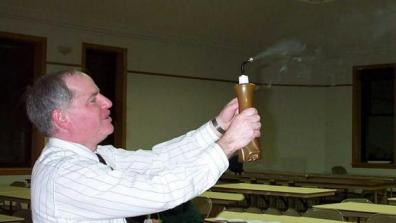
This looks like it was an exhalation after about 10 previous exhalations, not that much is seen in this particular photo. I normally get a tremendous amount of smoke out of the bottle with every drag, normally we can smoke up a room with one cigarette. If you look at the mouthpiece of the bottle, it is almost solid brown with tar. It used to be clear. I have used this bottle with somewhere between 300 and 400 cigarettes. While that may sound like a lot, most people smoke more than that in any given month. Even the bottle is pretty yellow and I blow out almost all of the smoke used when it inhales. The bottle is dry allowing me to do this, your lungs are moist trapping most of the tars when inhaled. Literally over 90% of the tar that is inhaled stays in the lung, when you see a person exhale they are literally blowing out about 10% of the smoke.
You can see how the smoke had darkened the bottle after about a few hundred cigarettes. You can start to see how the smoker's lungs below became so discolored. Smokers don't just put a total of a few hundred cigarettes in their system; they literally deliver hundreds of thousands of cigarettes over their shortened lifetime. This discoloration effect is more than just aesthetically unpleasant--it is in fact deadly.
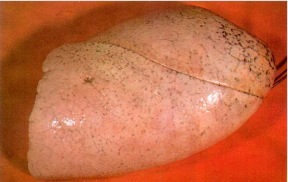
Above: Normal city dwellers lung. Note black specks throughout indicative of carbon deposits from pollution. Compare this to the lung below.

Smokers lung with cancer. White area on top is the cancer, this is what killed the person. The blackened area is just the deposit of tars that all smokers paint into their lungs with every puff they take.
To add a little more perspective to the demonstration, here is another way to see how much tar actually gets into the lungs from smoking. Below is the picture of a smoking machine.
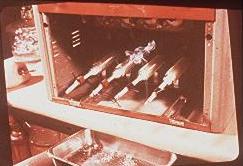
This machine smokes 2,000 cigarettes a day, mimicking smokers puffing patterns to capture equivalent amounts of tar as would a smoker. In one day the machine captures the amount of smoke in the picture below.
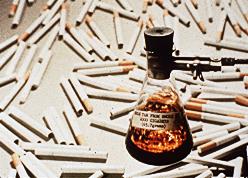
The bottle above with the tar collected from 2,000 cigarettes. If a diluted form (diluted, not concentrated is as often done in animal experimentation to demonstrate that chemicals are carcinogens) of this tar is painted on the skin of mice, 60% of the animals developed cancer of the skin within a year.

Many chemicals currently banned for human consumption were removed from usage if they even caused 5% or less cases of cancer in similar experiments. Cigarette tars contain some of the most carcinogenic chemicals known to man. Consider this when watching people smoking and exhaling only 10% of the tars they actually take in. Not only are these chemicals being painted into the lung, but smoker are also constantly painting them up on their lips, tongue, larynx, swallowing some and thus painting it in the esophagus and throughout the digestive tract. Smokers have increased incidents of cancer in all of these exposed sites.
Now that you know what it looks like on a large scale and feels like, lets take a look at the microscopic level of things that happen in the lung from smoking.
The following series of slides illustrate microscopic changes that happen when a person smokes. The first slide is showing an illustrated blow-up of the normal lining of the bronchus.
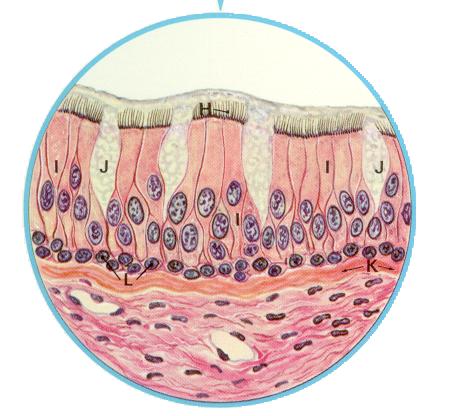
On the top we see the cilia, labeled (H). They are attached to columnar cells, labeled (I). The cilia sweep the mucous produced in the goblet cells, labeled (J) as well as mucous coming from deeper glands within the lungs and the particulate matter trapped in the mucous. The bottom layer of cells, labeled (L) are the basal cells.
Below we start to see the changes that occur as people begin to smoke. You will see that the columnar cells are starting to be crowded out and displaced by additional layers of basal cells. Not only are fewer cilia present but the ones that are still functioning are doing so at a much lower level of efficiency. Many chemicals in tobacco smoke are toxic to cilia, first slowing them down, soon paralyzing them all together and then destroying them.
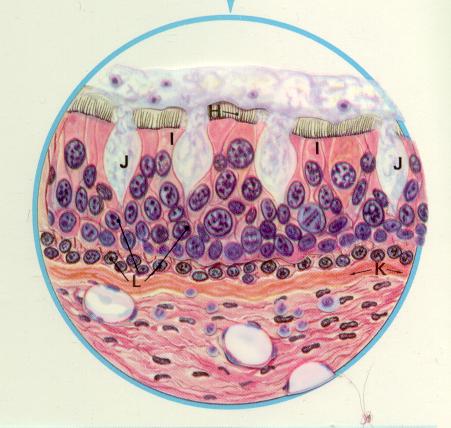
As you see with the cilia actions being diminished, mucous starts to build up in the small airways making it harder for the smoker to breathe and causing the characteristic smokers cough in order to clear out the airways.
Eventually though, the ciliated columnar cells are totally displaced. As can be seen below ominous changes have taken place. Not only is the smoker more prone to infection from the loss of the cleansing mechanism of the cilia, but these abnormal cells (O) are cancerous squamous cells. These cells will eventually break through the basement membrane wall and invade into underlying lung tissue and often spread throughout the body long before the person even knows they have the disease.
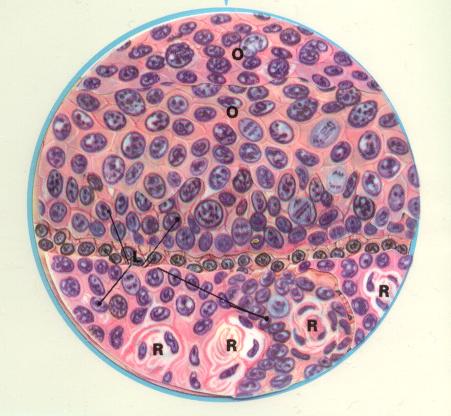
If a smoker quits before cancer actually starts, even if the cells are in a precancerous state, the process is highly reversible. Cilia regeneration starts in about 3 days once smoking stops. Even if cilia has been destroyed and not present for years, the lining tissue of the windpipe will start to repair. Even the precancerous cells will be sloughed off over time, reversing the cellular process to the point where the lining tissue goes back to normal. But if a smoker waits too long and cancer starts, it may be too late to save his or her life.
Following are actual pathological slides showing these same damaging effects.
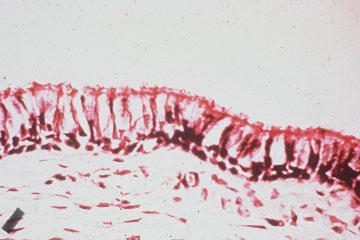
The little pink hairlike projections on the top is the cilia and if you compare this image with the illustrations above you should be able to see the mucous secreting cells and the separation of the lining tissue from the underlying lung tissue.
Below you can see the same area of tissue from a smoker's lung who has totally destroyed the cilia in this tissue.
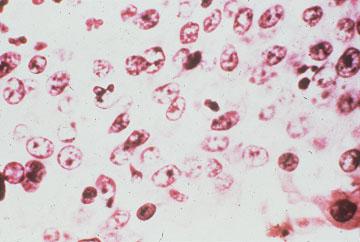
Again note, where there used to be two layers of well formed and organized basal cells, now numerous layers of disorganized squamous cells has replaced the normal defensive tissue. These cells are precancerous and if the continued irritation (cigarette smoke) is not ceased can go to that final stage where they become malignant and invade into the underlying lung tissue as seen below.

Then it is only a matter of time before it leaves the lung and spreads throughout the body. If the smoker quits smoking before this last cellular change occurs, before a cell turns malignant, the process seen in this last slide can be avoided. In fact much of the damage seen in the second picture here is highly reversible.
In three days cilia start to regenerate and usually within 6 months the normal cilia function is returned. Also over time, the extra layers of cells will be sloughed off and the lining tissue of the bronchus will return to normal.
Unfortunately, if a smoker waits until a malignancy has started, the outlook is grim. The overall 5 year survival rate for lung cancer is only 14%. Lung cancer, is a disease that while once uncommon, is now the leading cancer killer in both sexes.
Cancer is actually many different diseases with many different causes. If we look at cancer trends over the last century we see some amazing changes. While cancer was always around, it was different sites that were primary problems. Lung cancer, at the turn of the century was almost unheard of. If a doctor saw a case he would have easily gotten it printed up in a medical journal. Now, it is the major cause of cancer death in our society, killing more men and women than any other site. The primary difference between now and then is smoking. Before the turn of the century smoking was a limited practice. A very small percentage of people smoked and even the ones who did smoked many fewer cigarettes. Cigarettes were not even mass produced till the very end of the 1900's.
We always hear of a cancer epidemic, how more and more people die of cancer every year. Actually, if you pull the smoking related sites out of the equation, cancer deaths have been on a decline. Some sites, like stomach the incidence dropped dramatically, not fully understood as to why. Other sites, like breast, even though the morbidity rate (number of cases) didn't drop, because we now have better treatments and earlier detection, the mortality (death) rate has dropped.
But the smoking cancers; lung, mouth, lip, tongue, throat, larynx, pancreas, esophagus, pharynx, urinary bladder have all seen marked increases over the 20th century. These cancers have gone from obscurity to some of the major causes of death in our country. Actually, for the first time in a hundred years we are starting to see an early decline of morbidity and mortality because we are seeing fewer smokers now with the drop in the percentages of adult smokers.
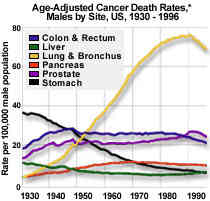
Men
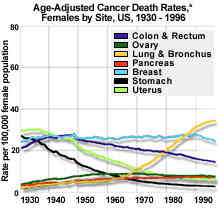
Women
You see a dramatic difference in men and women, especially in lung cancer rates. The reason is women started smoking much later than men, about a 30 year time delay before it became socially acceptable for women to smoke. Male smoking rate jumped dramatically between World War I and another big boost during World War II. Free distribution of cigarettes to soldiers was a big factor. Women smoking rates happened much later and the time delay is reflected in the time delay in cancer and other diseases going up too.
The above pictures were primarily about how smoking causes cancer of the lung and other sites. But the assault on the lungs from the tars in tobacco are not just limited to causing cancer. Other lung diseases are directly caused by smoking, the most well known are the chronic obstructive lung diseases.
The most well known smoking induced COPD is emphysema. This is another one of those diseases that primarily happen to smokers. Over 90% of the cases are smoking induced. There are cases in some families where there does seem to be a genetic predisposition, where non-smokers get it too. This is from a rare condition, a lack of a blood enzyme called alpha1antitrypsin. This again is rare, but if you do have family members who never smoked a day in their life get emphysema there may be a genetic tendency. But again, over 90% of emphysema cases are simply caused by smoking. Eradicate smoking and you eradicate the risk of the disease.
To get a sense of how a lung is altered by smoking to cause emphysema look at the pictures below. The first is a picture of an inflated non-smoker city dweller's lung.
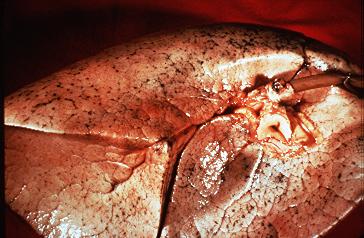
As in the normal picture of a lung above, you can see carbon deposits collected throughout from pollution effects. But when contrasted with a smoker's lung with emphysema...
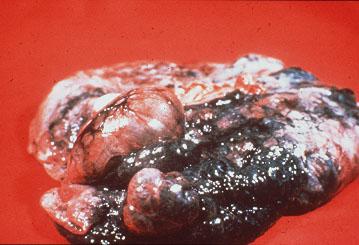
...there is a very dramatic visible difference. Not only is the discoloration the issue, but the lungs have literally been ripped out of shape making breathing extremely difficult and eventually impossible. To get a sense of what it feels like to breathe with emphysema take a deep breath and hold it. Without letting out any air, take another deep breath. Hold that one too. One more time, take one more breath. Okay let it all out.
That second or third breath is what it feels like to breathe when you have advanced emphysema. Emphysema is a disease where you cannot exhale air. Everyone thinks that it is a disease where you cannot inhale but in fact it is the opposite. When you smoke you destroy the lungs elasticity by destroying the tissue that pulls your lung back together after using muscles that allow us to inhale air. So when it comes time to take your next breath it is that much more difficult, for your lungs could not get back to their original shape.
Imagine going through life having to struggle to breathe like those last two breaths I had you take. Unfortunately, millions of people don't have to imagine it, they live it daily. It is a miserable way to live and a slow painful way to die.
Hopefully when you breathe normally today you are not in pain and you are not on oxygen. If you don't smoke you will continue to give yourself the ability to breathe longer and feel better. Never lose sight of this fact. To keep your ability to breathe better for the rest of your life always remember to - NEVER TAKE ANOTHER PUFF!
Share this article
Watch Joel's lung, lung cancer and emphysema videos
Feel what it's like to breathe with emphysema
How smoking causes lung cancer
Why many people cough more after quitting
The Palmolive bottle demonstration
"My smoking helps me to breathe better"
Lung cancer: Isn't there a cure just around the corner?
Will my lungs ever look better?
Other videos related to heath consequences of smoking
Next Cost of Smoking Lesson

